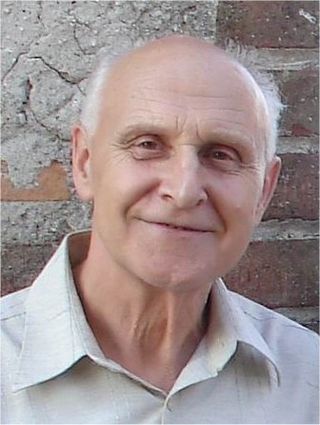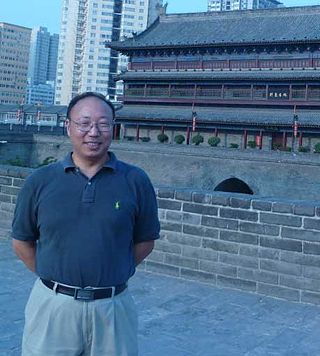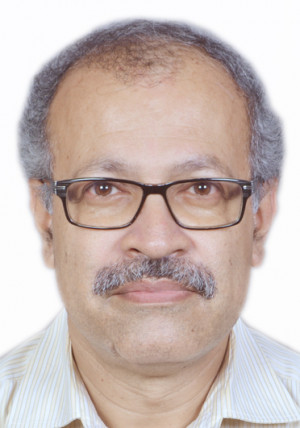Related Research Articles

Chaos theory is an interdisciplinary area of scientific study and branch of mathematics focused on underlying patterns and deterministic laws of dynamical systems that are highly sensitive to initial conditions, and were once thought to have completely random states of disorder and irregularities. Chaos theory states that within the apparent randomness of chaotic complex systems, there are underlying patterns, interconnection, constant feedback loops, repetition, self-similarity, fractals, and self-organization. The butterfly effect, an underlying principle of chaos, describes how a small change in one state of a deterministic nonlinear system can result in large differences in a later state. A metaphor for this behavior is that a butterfly flapping its wings in Texas can cause a tornado in Brazil.

In mathematics, a dynamical system is a system in which a function describes the time dependence of a point in an ambient space, such as in a parametric curve. Examples include the mathematical models that describe the swinging of a clock pendulum, the flow of water in a pipe, the random motion of particles in the air, and the number of fish each springtime in a lake. The most general definition unifies several concepts in mathematics such as ordinary differential equations and ergodic theory by allowing different choices of the space and how time is measured. Time can be measured by integers, by real or complex numbers or can be a more general algebraic object, losing the memory of its physical origin, and the space may be a manifold or simply a set, without the need of a smooth space-time structure defined on it.

Ralph Herman Abraham is an American mathematician. He has been a member of the faculty of the University of California, Santa Cruz since 1968.

Dynamical systems theory is an area of mathematics used to describe the behavior of complex dynamical systems, usually by employing differential equations or difference equations. When differential equations are employed, the theory is called continuous dynamical systems. From a physical point of view, continuous dynamical systems is a generalization of classical mechanics, a generalization where the equations of motion are postulated directly and are not constrained to be Euler–Lagrange equations of a least action principle. When difference equations are employed, the theory is called discrete dynamical systems. When the time variable runs over a set that is discrete over some intervals and continuous over other intervals or is any arbitrary time-set such as a Cantor set, one gets dynamic equations on time scales. Some situations may also be modeled by mixed operators, such as differential-difference equations.
Nancy Laura Stokey has been the Frederick Henry Prince Distinguished Service Professor of Economics at the University of Chicago since 1990 and focuses particularly on mathematical economics while recently conducting research about Growth Theory, economic dynamics, and fiscal/monetary policy. She earned her BA in economics from the University of Pennsylvania in 1972 and her PhD from Harvard University in 1978, under the direction of thesis advisor Kenneth Arrow. She is a Fellow of the Econometric Society, the American Academy of Arts and Sciences and the National Academy of Sciences. She previously served as a co editor of Econometrica and was a member of the Expert Panel of the Copenhagen Consensus. She received her Honorary Doctor of Laws (L.L.D) in 2012 from the University of Western Ontario.

Lennart Axel Edvard Carleson is a Swedish mathematician, known as a leader in the field of harmonic analysis. One of his most noted accomplishments is his proof of Lusin's conjecture. He was awarded the Abel Prize in 2006 for "his profound and seminal contributions to harmonic analysis and the theory of smooth dynamical systems."

Oleksandr Mykolayovych Sharkovsky was a Ukrainian mathematician most famous for developing Sharkovsky's theorem on the periods of discrete dynamical systems in 1964.
In mathematics, topological dynamics is a branch of the theory of dynamical systems in which qualitative, asymptotic properties of dynamical systems are studied from the viewpoint of general topology.

The finite element method (FEM) is a popular method for numerically solving differential equations arising in engineering and mathematical modeling. Typical problem areas of interest include the traditional fields of structural analysis, heat transfer, fluid flow, mass transport, and electromagnetic potential.

Howell Tong is a statistician who has made fundamental contributions to nonlinear time series analysis, semi-parametric statistics, non-parametric statistics, dimension reduction, model selection, likelihood-free statistics and other areas. In the words of Professor Peter Whittle (FRS): "The striking feature of Howell Tong's … is the continuing freshness, boldness and spirit of enquiry which inform them-indeed, proper qualities for an explorer. He stands as the recognised innovator and authority in his subject, while remaining disarmingly direct and enthusiastic." His work, in the words of Sir David Cox, "links two fascinating fields, nonlinear time series and deterministic dynamical systems." He is the father of the threshold time series models, which have extensive applications in ecology, economics, epidemiology and finance. Besides nonlinear time series analysis, he was the co-author of a seminal paper, which he read to the Royal Statistical Society, on dimension reduction in semi-parametric statistics by pioneering the approach based on minimum average variance estimation. He has also made numerous novel contributions to nonparametric statistics, Markov chain modelling, reliability, non-stationary time series analysis and wavelets.
Valentin Afraimovich was a Soviet, Russian and Mexican mathematician. He made contributions to dynamical systems theory, qualitative theory of ordinary differential equations, bifurcation theory, concept of attractor, strange attractors, space-time chaos, mathematical models of non-equilibrium media and biological systems, travelling waves in lattices, complexity of orbits and dimension-like characteristics in dynamical systems.
Anna Nagurney is a Ukrainian-American mathematician, economist, educator and author in the field of Operations Management. Nagurney is the Eugene M. Isenberg Chair in Integrative Studies in the Isenberg School of Management at the University of Massachusetts Amherst in Amherst, Massachusetts. Previously, she held the John F. Smith Memorial Professorship of Operations Management at the Isenberg School of Management from 1998 to 2021.
Alberto Adrego Pinto is a full professor at the Department of Mathematics, Faculty of Sciences, University of Porto (Portugal). He is a researcher of the Laboratory of Artificial Intelligence and Decision Support, Institute for Systems and Computer Engineering LIAAD, INESC TEC. He is the founder and editor-in-chief of the Journal of Dynamics and Games, published by the American Institute of Mathematical Sciences (AIMS). He is the President of the Portuguese International Center for Mathematics (CIM). Currently, he is also a Special Visiting Researcher from CNPq at Instituto Nacional de Matemática Pura e Aplicada (IMPA), Rio de Janeiro, Brazil.

Caroline Mary Series is an English mathematician known for her work in hyperbolic geometry, Kleinian groups and dynamical systems.

Albert C.J. Luo is a distinguished research professor of mechanical engineering at Southern Illinois University, Edwardsville, IL, USA. Luo is an internationally recognized scientist in the field of nonlinear dynamics and mechanics. His principal research interests lie in the field of Hamiltonian chaos, nonlinear mechanics, and discontinuous dynamical systems.

Soumitro Banerjee is an Indian electrical engineer and a professor at the Department of Physical Sciences of the Indian Institute of Science Education and Research, Kolkata. He is known for his studies on bifurcation phenomena in power electronic circuits and is an elected fellow of all three major Indian science academies: the National Academy of Sciences, India, Indian Academy of Sciences, and Indian National Science Academy. He is also a fellow of The World Academy of Sciences, Institute of Electrical and Electronics Engineers, West Bengal Academy of Sciences and the Indian National Academy of Engineering. The Council of Scientific and Industrial Research, the apex agency of the Government of India for scientific research, awarded him the Shanti Swarup Bhatnagar Prize for Science and Technology, one of the highest Indian science awards for his contributions to Engineering Sciences in 2003.

Volodymyr Koshmanenko — Ukrainian mathematician, Doctor of Science, professor, Leading Researcher of the Institute of Mathematics of the NAS of Ukraine.

Yakov Borisovich Pesin was born in Moscow, Russia on December 12, 1946. Pesin is currently a Distinguished Professor in the Department of Mathematics and the Director of the Anatole Katok Center for Dynamical Systems and Geometry at the Pennsylvania State University (PSU). His primary areas of research are the theory of dynamical systems with an emphasis on smooth ergodic theory, dimension theory in dynamical systems, and Riemannian geometry, as well as mathematical and statistical physics.
Guoqiang Tian is a Chinese-American economist. He is the Alfred F. Chalk Professor of Economics at Texas A&M University. He is Honorary Dean of Institute for Advanced Research at Shanghai University of Finance and Economics.
Laura Gardini is an Italian mathematician who studies chaos in dynamical systems, with applications in mathematical finance. She is professor in mathematics for economic applications at the University of Urbino.
References
- 1 2 3 4 Curriculum vitae (PDF), retrieved 2023-01-21
- ↑ Bischi, Gian Italo (7 July 2022), "Fare ricerca sotto le bombe: intervista alla matematica ucraina Iryna Sushko (English version)", Prisma, retrieved 2023-01-21
- ↑ Reviews of Continuous and Discontinuous Piecewise-Smooth One-Dimensional Maps: Adriana Buică, Zbl 1452.37002; Michał Misiurewicz, SIAM Review, doi:10.1137/20N975038; Davide Radi, Journal of Difference Equations and Applications, doi:10.1080/10236198.2021.1971210
- ↑ Review of Global Analysis of Dynamic Models in Economics and Finance: Essays in Honour of Laura Gardini: Adriana Horníková, Technometrics, JSTOR 24587285